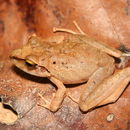Description
provided by AmphibiaWeb articles
Males 25-32 mm, females 35-45 mm. The background dorsal coloration has diverse tones of brown. The ventral surface is creamy, and the throat has dark markings. The hind limbs are longer than the body. The upper and lower lips have dark and light bars. There is a dark stripe over the tympanum. The toes are long with expanded T-shaped tips. The iris is golden with a median, horizontal orange streak.Similar species: Juveniles can be confused with Adenomera andreae or Dendrophrynischus minutus, but only P. fenestratus has T-shaped tips on its toes.
- author
- Albertina P. Lima
- author
- William E. Magnusson
- author
- Marcelo Menin
- author
- Luciana K. Erdtmann
- author
- Domingos J. Rodrigues
- author
- Claudia Keller
- author
- Walter Hödl
Distribution and Habitat
provided by AmphibiaWeb articles
Occurs throughout the Reserva Florestal Adolpho Ducke in Brazil, and is frequently found on fallen leaves and leaves of shrubs.
- author
- Albertina P. Lima
- author
- William E. Magnusson
- author
- Marcelo Menin
- author
- Luciana K. Erdtmann
- author
- Domingos J. Rodrigues
- author
- Claudia Keller
- author
- Walter Hödl
Life History, Abundance, Activity, and Special Behaviors
provided by AmphibiaWeb articles
The species is terrestrial. Juveniles are diurnal, and adults are nocturnal. It feeds mainly on collembolans, homopterans, spiders, beetles and crickets. Reproduction occurs from November to May. Males are territorial and usually call from leaf litter, branches or shrubs, 10-60 cm above the ground. Clutches contain 10-20 eggs deposited in the soil under fallen leaves. Development to metamorphosis occurs in the eggs.
- author
- Albertina P. Lima
- author
- William E. Magnusson
- author
- Marcelo Menin
- author
- Luciana K. Erdtmann
- author
- Domingos J. Rodrigues
- author
- Claudia Keller
- author
- Walter Hödl

